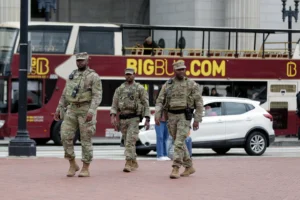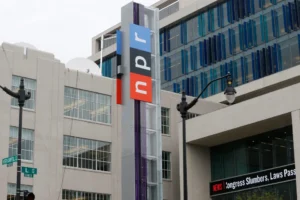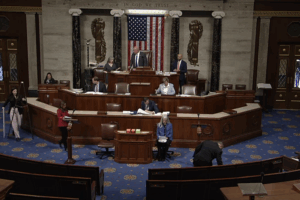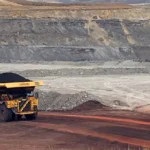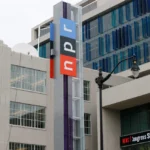BLM Plan Would Hike Bond Requirements on Oil and Gas Drilling
Changes proposed for Wyoming, as many wells are left idle and unplugged after production ceases
- Published In: Politics
- Last Updated: Aug 29, 2023
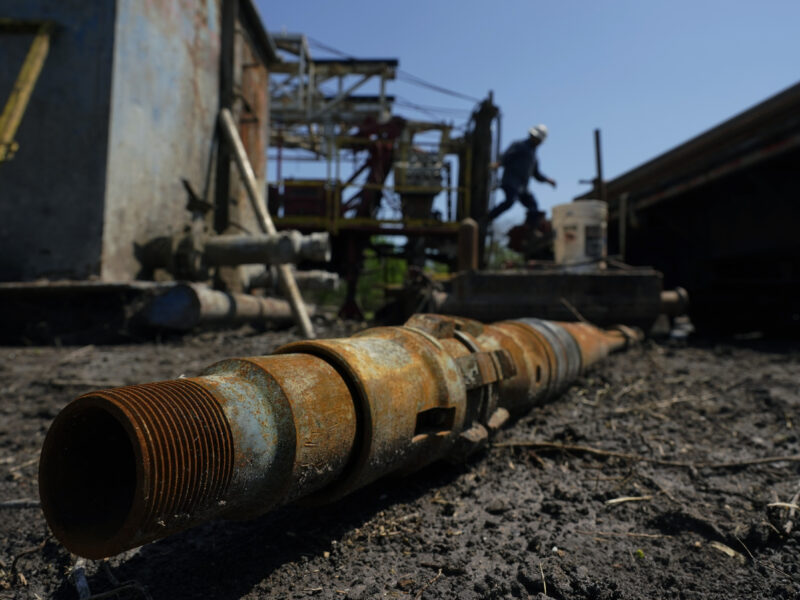
An oil well worker moves equipment at a site on the Rooke family ranch where an orphaned well was plugged, Tuesday, May 18, 2021, near Refugio, Texas. The Bureau of Land Management spent $2 million to plug 16 orphaned wells in Wyoming in 2021, and there are currently another 15 orphaned oil wells in the state, according to BLM spokesman Micky Fisher. (AP Photo/Eric Gay)
By K.L. McQuaid
Special to the Wyoming Truth
The federal Bureau of Land Management (BLM) has proposed significantly hiking bonding requirements for oil and gas producers on federal lands in Wyoming and throughout the West.
Under a proposal introduced late last month, BLM would raise the amount of money oil and natural gas operators would have to pay in bonds – from $10,000 to $150,000 for individual drilling leases and from $25,000 to $500,000 for a statewide bond.
The agency’s goal is to reduce taxpayers’ financial exposure and burden in plugging and cleaning up thousands of idled or abandoned wells, which are defined as those that have been “non-operational for at least seven years” and have “no anticipated beneficial use.”
Though the cost to plug and reclaim an idled well varies from $7,000 to $200,000, the average cost is about $71,000, the agency notes. A 2019 report from the U.S. Government Accounting Office (GAO) found that 84% of bonds issued were not sufficient to cover reclamation and plugging costs.
Current drilling bond amounts “do not adequately protect the fiscal interests of the American public,” BLM wrote in support of increasing the bonds.
“There are thousands of idled wells on Federal lands, many of which have not produced oil or gas in years,” the agency wrote in material to support the increases.
Smaller operators, in particular, often abandon wells when production wanes, and they seek bankruptcy protection to avoid paying plugging expenses.
BLM notes that the government has not raised its bonding amounts since 1960. The new amounts take into account the rate of inflation over the past 60 years. The 2022 equivalent of a $10,000 bond issued in 1960, for instance, would be $100,105.
Likewise, a statewide bond of $25,000 issued in 1951 – the last time that figure was adjusted – would in 2022 dollars fetch $284,914. Today, because the median number of wells tied to a statewide bond is seven, and the average cost to cap is $71,000, BLM rounded up the $497,000 figure to $500,000.
Bonds typically fetch about 1% to 5% of the bonded amount, meaning a $10,000 bond costs no more than $500 and a $25,000 bond no more than $1,250.
The agency believes that the higher bonding amounts would discourage operators from simply walking away from wells and provide money to cap wells that have been left idle.
Uncapped wells and those that are not reclaimed can lead to groundwater and soil contamination, along with increased levels of air pollution around the well.
Idled wells also often leak methane, a potent greenhouse gas, and benzene, a carcinogen, among other chemicals.
Shifting cleanup costs
In some cases, private ranchland and farmland become contaminated from BLM subsurface oil or natural gas leases on neighboring federal land.
In 2021, BLM spent $2 million to plug 16 orphaned wells in Wyoming, said Micky Fisher, a BLM spokesman.
There are currently another 15 orphaned oil wells in the state, Fisher told the Wyoming Truth. In all, some 130,000 abandoned or idled wells dot the U.S. states, he said.
Environmental groups have praised the proposal as a way to shift cleanup costs to operators and producers—and away from taxpayers.
“Operators have decided that it’s been easier economically for them to forfeit whatever bond amounts they’ve put down rather than properly plug these wells,” said Katherine Stahl, a community organizer with the Powder River Basin Resource Council, a Sheridan-based group that has been working to revamp the BLM’s bonding system for nearly two decades. “They’ve inadvertently been incentivized to abandon some of these wells.
A federal GAO report from last year identified 2,300 wells nationwide that had not produced oil or gas since at least 2008 and that had not been plugged or reclaimed, according to the BLM rule proposal as contained in the Federal Register.
The office found that reclamation costs could reach $330 million in all and that bonds on those wells would not cover the anticipated cleanup costs.
BLM’s Fisher said the GAO reports and similar examinations by the U.S. Office of the Inspector General prompted the BLM to reconsider its bonding processes and amounts.
At the end of the 2022 federal fiscal year, BLM managed 34,409 oil and gas leases on federal land, covering 89,350 wells capable of production on 23.7 million acres, according to the Federal Register.
Of those, the GAO concluded that roughly 48% of the wells, on about 11 million acres, were not producing.
In Wyoming, the state’s Oil & Gas Commission administers oil and gas leases and also maintains a bonding system to hold operators accountable. The commission’s bonds are for $100,000 per lease.
The commission also charges a “conservation tax” on production that goes into an orphaned well fund for cleanups. So far this year, the state has plugged about 200 orphaned wells, according to reports.
Between 2014 and 2022, the state plugged about 5,000 wells. It estimates roughly 1,500 orphan wells remain unplugged on state land.
Both Stahl of the Powder River Basin Resource Council and officials from the Petroleum Association of Wyoming have lauded the Oil & Gas Commission’s handling of bonding and reclamations, especially its conservation tax.
Petroleum Association officials did not respond to requests for comment regarding the proposed BLM rule changes regarding bonds.
BLM’s Fisher said the agency has not worked to implement a conservation tax because congress has not authorized it to do so.
BLM is holding a series of public meetings on the proposed rule changes on Sept. 9 in Denver, Sept. 12 in Salt Lake City and on Sept. 19 via an online virtual meeting. The comment period will end on Sept. 22. To date, over 1,900 comments have been logged on the BLM’s website.
Fisher said the rule changes, if adopted, likely won’t be approved until sometime in 2024, and there would be a phase-in period following the effective date for existing bond holders’ compliance of up to two years, depending on the type of bond.
The increased bonding mechanism, if finalized, wouldn’t be the only source of additional funding to cap and reclaim idled wells, either.
Another $4.7 billion was included in the Infrastructure Investment and Jobs Act, which was passed in November 2021, to plug inactive and abandoned wells nationwide.
“We, as a group, very much support this proposed rule,” Powder River Basin’s Stahl said of the BLM proposal. “It’s great to see this, because it’s been so disappointing to discover how frequently this abandoning of wells happens.”


